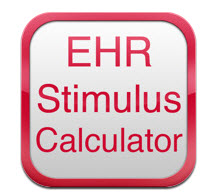EHR Stimulus Incentive
EHR technology is a medical software that can help your practice keep track of and treat patients more efficiently and effectively. Additionally, many of these technologies, when implemented correctly and used properly, are subject to government incentives, making them affordable to install.
 With the Stimulus Incentive Calculator app for the iPhone, you can figure out how much you will earn by using certified EHR software. Using various factors, such as the size of your practice and the number of patients you see per year, this calculator can show you the incentives for which you may be eligible.
With the Stimulus Incentive Calculator app for the iPhone, you can figure out how much you will earn by using certified EHR software. Using various factors, such as the size of your practice and the number of patients you see per year, this calculator can show you the incentives for which you may be eligible.
To learn more about the benefits of using EHR technology in your practice, contact PathMaker Group. We provide security solutions and identity management servicesw.
Visit our website or call (817) 704-3644.
